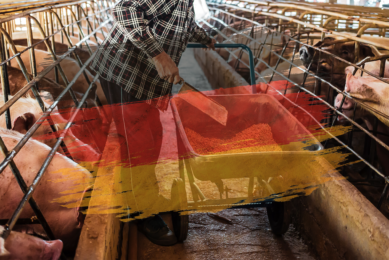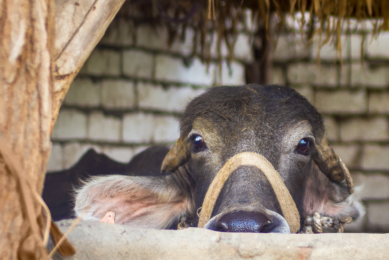Beating odour with Yucca schidigera

Some petfoods are supplemented with a yucca schidigera preparation and have a claim on waste-odour control. A review of twelve feeding studies indicates that yucca ?substances generally reduce group-mean odour offensiveness of dog and cat faeces.
By Anton C. Beynen and Daniëlle H.J. Saris, Vobra Special Petfoods, the Netherlands
Dog and cat excrements smell pretty bad and the compulsory faecal pickup after the urban dog or the cleaning of the cat litter box is not appreciated. Clearly, control of waste odour will give an extra zest to pet ownership and pet food companies may add some kind of yucca schidigera preparation to their products as basis for a claim on waste-odour control. Schidigera is a species of yucca with high levels of steroid saponins. Yucca as petfood ingredient may consist of the shredded plant, which is dried, pulverised and ground. Yucca preparations are also derived from juice extracted from yucca fibres, and can be in the form of powder or granulate. In this article, we highlight a number of studies in dogs and cats.
Studies in dogs
Lowe and Kershaw (1997) fed four dogs on an extruded diet with and without yucca schidigera preparation (Odor-BlocTM) at inclusion level of 250 mg/kg. The dogs were switched from the control to the test diet. Faecal samples were collected prior to diet change and at the end of the 21-days test period. The faeces were put into bags, which were then sealed and frozen. For odour testing, the faeces were thawed and homogenised, while remaining in the bag. The blind experiment was assessed by three panelists. A rank-order test principle was used and scores assigned on a scale of 1-5, with 5 being most offensive. Average baseline and treatment scores were 5.0 and 2.3, respectively. In two of the dogs fed the control diet again for 14 days, the mean score was 4.5. Earlier, Lowe (1991) studied the effect of another yucca schidigera substance. Two groups of dogs received a dry food to which 0, 150, 250 or 350 mg De-OdoraseTM/kg was added. After 14 days on the control diet, the dogs received the three test diets and again the control diet for consecutive 7-day periods. Faecal odour was evaluated by a panel using a 1-5 scale. Mean scores for baseline, increasing yucca levels and post treatment were 3.9, 2.8, 2.2, 2.4 and 4.6. Maia et al. (2010) tested a dry control diet to which a yucca schidigera preparation was added at concentrations of 0, 125, 250 or 375 mg/kg. The brand of the yucca preparation used is not given. There were two dogs per treatment. After six days, faeces were collected and odour scored on a 1-10 scale. The score of 5 was assigned to the control faeces; lower and higher figures corresponded with less and more agreeable. Mean odour scores for the test diets were 5.0, 5.6 and 5.6. In the trial of Reis and Saad (2011), dogs were administered for 14 days one of two dry diets and a placebo capsule or encapsulated yucca schidigera preparation of unmentioned brand. A restricted feeding regimen was used and the yucca doses were equivalent to 0, 250, 500 or 750 mg/kg diet. There were 5 dogs per treatment. Fresh faeces were collected and evaluated by a panel. Faecal odour for each test diet was compared with that of the controlled diet. The results are presented as percentage observations similar to the control, more or extremely more offensive and less or extremely less offensive. The distributions for the six test diets were almost identical.
Yucca with granular carrier
The impact of the yucca schidigera preparation Micro-Aid® has been studied in two dog experiments (McFarlane and DPI Global, marketing summaries 8801D and 8802D). This product is made by drying the yucca liquid extract into a granular carrier. In one experiment, a dry dog food was supplemented with 0, 124 or 248 mg substance/kg diet. The diets were fed to six dogs, housed two per pen, according to a 3 x 3 Latin square, with feeding periods of a week. On the last day of each period, faeces were collected and samples were evaluated by a group of odour-panelists. The ranking scheme consisted of low, intermediate or highly odorous. On average, faecal samples from the dogs fed the yucca extract at 0, 124 or 248 mg/kg ranked highly odorous at 83, 17 and 0% of the time. The panelists also assessed the faecal samples by comparing odour intensity to a reference scale comprised of known concentrations of 1-butanol in distilled water. Faecal odour intensity was expressed as equivalent butanol concentration. The decrease in butanol concentration below that of control samples was 32 and 56% for the diets with 124 and 248 mg yucca preparation/kg. In the other experiment with Micro-Aid®, six individually-housed dogs were fed on two dry foods or one canned product without or with 248 mg granules/kg. The design consisted of three 2 x 2 Latin squares with feeding periods of a week. Faecal samples were assessed as indicated, but ranked low or high in odour offensiveness. On average, samples corresponding with dietary yucca at 0 or 248 mg/kg ranked highly odorous at 66 and 39% of the time. The yucca-induced decrease in equivalent butanol concentration was 20%.
Studies in cats
In two cat experiments, Lowe and Kershaw (1997) fed different powdered yucca-schidigera products (Odor-BlocTM, Desert KingTM) at 125 mg/kg extruded diet. Within each experiment, four cats received the test diet for 23 days. With the use of special litter trays, samples of non-contaminated faeces were collected pre- and post-treatment. Frozen faeces were thawed and odour expressed on a 1-5 scale. The butanol reference method was applied also. Mean baseline and final scores were 2.8 and 1.9 in one experiment and 2.6 and 1.3 in the other. On a butanol reference scale the yucca effects were lower by 3 and 9%. In one study with cats, a canned food with 0, 124 or 248 mg Micro-Aid®/kg was used, and in another study five foods (dry, semi-moist or canned) were supplemented with the preparation at 0 or 124 mg/kg (McFarlane and DPI Global, marketing summaries 8803C and 8805D). The former diets were fed to two cats, housed together, during one-week periods. Faecal samples from the two cats fed on the yucca granules at increased concentrations ranked highly odorous at 50, 25 and 25% of the time. The two yucca levels lowered equivalent butanol concentration by 25%. The five diets with and without yucca were fed to pairs of cats in five cross-over experiments with one-week feeding intervals. The overall decrease in equivalent butanol concentration was 24%. Roque et al. (2011) used a wet food enriched with 0, 125, 250 or 375 mg yucca schidigera/kg dietary dry matter. There were three individually housed cats per treatment. Brand of yucca preparation and duration of feeding are not indicated. Odour of fresh faeces was scored by cat fanciers on a 1-4 scale. Score 2 was the reference for control faeces and higher scores were for less malodorous samples.
Mean scores for the diets with increasing yucca concentrations were 2.6, 1.2 and 2.4. In a double-blinded, placebo-controlled, in-home study, owners fed their cats a dry diet without (n = 12) or with (n = 11) 125 mg De-OdoraseTM/kg (Van de Riet, 2013). All owners were supplied with the same litter-box filler and used a standard amount per cat.
Litter boxes were scooped daily and filler was replaced weekly. In a booklet, the owners indicated the degree of malodor of excrements on a 100-mm line, with 0 being mild odour and 100 strongly annoying. Faeces was scooped and assessed and then the filler was scored for urine odour. Figure 1 shows that yucca consumption lowered group-mean offensiveness of faeces and urine odour.
Conclusion
Yucca ingestion generally improves the character and intensity of canine and feline aroma (Figure 2). The overall decrease in faecal offensiveness is 26%, although there will be considerable intra- and inter-individual variability in faecal aroma as perceived by panelists or owners. Owners are able to detect the effect of yucca on a group level, but it is unknown whether the degree of odour amelioration can be considered relevant in practice. In any event, a material portion of pet owners will not experience a beneficial impact of yucca. The 12 studies indicate that a dose of 125 mg yucca preparation/kg dry food generally is effective, but higher doses might have more impact. The efficacy of yucca schidigera added to petfoods will also depend on type of preparation and food composition, but no solid conclusions are possible.
References are available on request from the first author (beynen@freeler.nl)
[Source: AllAboutFeed magazine Vol 22 nr 2, 2014]











